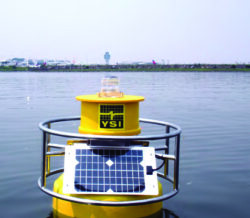 Monitoring for water quality in source waters can have a profound and positive impact on drinking water treatment. The benefits can range from better-tasting water to overall reduction in treatment costs. Water quality affects the efficiency of water treatment processes and informs facility operators as to how processes might be adjusted to adequately treat incoming water. Over time, water quality data can be used for understanding trends and developing correlations between water quality and treatment requirements.
Monitoring for water quality in source waters can have a profound and positive impact on drinking water treatment. The benefits can range from better-tasting water to overall reduction in treatment costs. Water quality affects the efficiency of water treatment processes and informs facility operators as to how processes might be adjusted to adequately treat incoming water. Over time, water quality data can be used for understanding trends and developing correlations between water quality and treatment requirements.
EPA Source Water Protection Guidelines require that each state identify and assess threats to its water supply sources, and operators are required to submit a report to the EPA’s Source Water Protection Office. With continuous monitoring, water treatment issues that are season-specific, such as harmful algae blooms, or event-specific, such as stormwater runoff, can be characterized and treatment contingencies developed.
The New York City Department of Environmental Protection (NYCDEP) wanted to upgrade its source water monitoring system and increase collection of real-time data to help with management and reporting. In some areas, technicians had been taking manual measurements in remote locations as often as once a day. NYCDEP started using buoy-based systems designed by YSI to continuously monitor water quality in two upstate reservoirs that are part of a larger system providing source water to New York City and other areas of the state. In operation now for many years, these systems have continued to be upgraded as the water quality sondes changed from YSI’s 6-series to EXO, and also as more automated monitoring systems, such as YSI vertical profilers, were brought into operation.
Some of NYCDEP’s water quality buoy stations include up to three YSI multiparameter sondes integrated into the EMM68 buoy platform. The sondes are suspended at different depths to more accurately represent water quality in vertical profile, and are used to measure temperature, dissolved oxygen, conductivity, specific conductance, pH, depth, and turbidity. Additional stations employ pontoon-based vertical profiling systems, a convenient way to accomplish the same monitoring objective with a single sonde per station. In either instance, solar panels charge on-board batteries to provide ample power for the sondes, a spread spectrum transceiver, and a datalogger.
Water quality data are stored within the dataloggers and transmitted via spread spectrum radio to a Signal Conditioning and Data Acquisition (SCADA) system that provides data in real time to water treatment facility operators. The SCADA system monitors water quality data using established criteria and performs automated functions such as activating alert messages or alarms. Under normal conditions, the sondes make measurements every 15 minutes. However, operators can remotely adjust sampling frequency at any site and with any sonde to more carefully investigate water quality within those reservoirs. The stations and sondes are inspected and the sondes recalibrated once per month. Gathering real-time data has helped NYCDEP improve its water quality monitoring program.
 The NYCDEP was an early leader in adopting this approach, which is now being replicated around the world as drinking water managers grapple with issues like harmful algal blooms, combined sewer overflows, and other insults to source waters. Being able to integrate data collection with existing infrastructure, such as a SCADA system, is one of the many ways that YSI’s Integrated Systems and Services team can help managers adapt a monitoring network to meet their needs. Alternatives to using a SCADA system include facilitating data visibility through YSI’s HydroSphere, a cloud-based platform that allows round-the-clock visibility of data. YSI can help design, install, and operate systems to suit almost any source water monitoring need.
The NYCDEP was an early leader in adopting this approach, which is now being replicated around the world as drinking water managers grapple with issues like harmful algal blooms, combined sewer overflows, and other insults to source waters. Being able to integrate data collection with existing infrastructure, such as a SCADA system, is one of the many ways that YSI’s Integrated Systems and Services team can help managers adapt a monitoring network to meet their needs. Alternatives to using a SCADA system include facilitating data visibility through YSI’s HydroSphere, a cloud-based platform that allows round-the-clock visibility of data. YSI can help design, install, and operate systems to suit almost any source water monitoring need.











